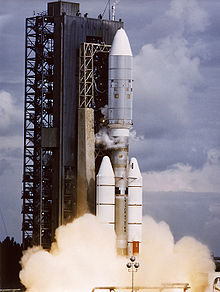
Back Титан IIIE Bulgarian Titan 3E-Centaur German Titan IIIE Spanish Titan IIIE Galician טיטן 3E HE टाइटन 3ई Hindi Titan IIIE ID Titan IIIE Italian टाईटन तृतीय ई Nepali Titan 3E Polish
 Launch of a Titan IIIE with Voyager 2 | |
| Function | Expendable launch system |
|---|---|
| Manufacturer | Martin Marietta Convair Aerospace Division of General Dynamics (prime contractor for the third stage Centaur D-1T) |
| Country of origin | United States |
| Size | |
| Height | 48.8 meters (160 ft)[1]: 142 |
| Diameter | 3.05 meters (10.0 ft)[1]: 142 |
| Mass | 632,970 kilograms (1,395,460 lb) |
| Stages | 3 with an option for 4 |
| Capacity | |
| Payload to Low Earth orbit | |
| Mass | 15,400 kilograms (34,000 lb) |
| Payload to Heliocentric orbit (TMI) | |
| Mass | 3,700 kilograms (8,200 lb) |
| Associated rockets | |
| Family | Titan |
| Launch history | |
| Status | Retired |
| Launch sites | Launch Complex 41 Cape Canaveral Air Force Station Cape Canaveral, Florida |
| Total launches | 7 |
| Success(es) | 6 |
| Failure(s) | 1 |
| First flight | February 11, 1974 |
| Last flight | September 5, 1977 |
| Type of passengers/cargo | Voyager (1 / 2) Viking (1 / 2) Helios (A / B) |
| Zero stage – Solid Rocket Boosters | |
| Powered by | UA1205 Chemical Systems Division of United Technologies[1]: 142 (two, five-segment, strap-on boosters) |
| Maximum thrust | 5,339 kilonewtons (1,200,000 lbf) (each booster)[2]: 2–1 |
| Specific impulse | 266 sec[2]: 2–1 |
| Burn time | 117 seconds[2]: 1–2 |
| First stage – Core First Stage | |
| Powered by | LR87-11 (two) Aerojet[1]: 142 |
| Maximum thrust | 2,313 kilonewtons (520,000 lbf)[2]: 2–1 or 2,091 kilonewtons (470,000 lbf)[1]: 142 |
| Specific impulse | 301.1 sec[2]: 2–1 |
| Burn time | 146 seconds[2]: 1–2 |
| Propellant | N2O4 / Aerozine 50[2]: 2–1 |
| Second stage – Core Second Stage | |
| Powered by | LR91-11 (one)) Aerojet[1]: 142 |
| Maximum thrust | 449 kilonewtons (101,000 lbf)[2]: 2–1 or 444.8 kilonewtons (100,000 lbf)[1]: 142 |
| Specific impulse | 318.7 sec[2]: 2–1 |
| Burn time | 210 seconds[2]: 1–3 |
| Propellant | N2O4 / Aerozine 50[2]: 2–1 |
| Third stage – Centaur D-1T | |
| Powered by | RL10A-3 (two) Pratt & Whitney Aircraft Division of the United Aircraft Corporation[2]: 1–6 |
| Maximum thrust | 66.7 kilonewtons (15,000 lbf) (each engine)[1]: 142 |
| Specific impulse | 444 sec |
| Burn time | 470 seconds |
| Propellant | LH2 / LOX[2]: 1–4 |
| Fourth stage – Star 37E | |
| Powered by | 1 solid Thiokol |
| Maximum thrust | 68 kilonewtons (15,000 lbf) |
| Specific impulse | 283.6 sec[3] |
| Burn time | 42 seconds |
| Propellant | Solid |
The Titan IIIE or Titan 3E, also known as the Titan III-Centaur, was an American expendable launch system. Launched seven times between 1974 and 1977,[4] it enabled several high-profile NASA missions, including the Voyager and Viking planetary probes and the joint West Germany-U.S. Helios spacecraft. All seven launches were conducted from Cape Canaveral Air Force Station Launch Complex 41 in Cape Canaveral, Florida.
- ^ a b c d e f g h Cite error: The named reference
Hydrogenwas invoked but never defined (see the help page). - ^ a b c d e f g h i j k l m Convair Aerospace Division of General Dynamics; Martin Marietta Aerospace (September 1973). Titan IIIE/Centaur D-IT Systems Summary (PDF) (Report). National Aeronautics and Space Administration. Archived (PDF) from the original on April 15, 2022. Retrieved June 5, 2018.
- ^ Krebs, Gunter (February 14, 2011). "Star-37". Gunter's Space Page. Retrieved June 6, 2018.
- ^ Wade, Mark. "Titan". Encyclopedia Astronautica. Archived from the original on August 5, 2008. Retrieved January 25, 2009.